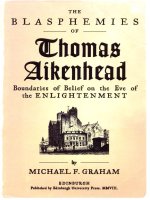edinburgh university press the linguistics students handbook may 2007
Bạn đang xem bản rút gọn của tài liệu. Xem và tải ngay bản đầy đủ của tài liệu tại đây (1.23 MB, 401 trang )
Linguistics
Student's
Handbook
Laurie Bauer
The
The book that tells you all the things you felt you were expected to know about linguistics, but
were afraid to ask about.
• What do you know about Burushaski and Miwok?
• What’s the difference between paradigmatic and syntagmatic?
• What is E-language?
• What is a language?
• What does the symbol ‘*’ mean in linguistics?
• What do you call the letter ?
• Do parenthetical and non-restrictive mean the same thing?
• How do you write a bibiliographic entry for a work you have not seen?
Every student who has asked these questions needs this book. A compendium of useful things
for linguistics students to know, from the IPA chart to the Saussurean dichotomies, this book
will be the constant companion of anyone undertaking studies of linguistics. P
art reference
work, part revision guide, and with tables providing summary information on some 280
languages, the book provides a new learning tool as a supplement to the usual textbooks and
glossaries.
Laurie Bauer is Professor of Linguistics, Victoria University of Wellington.
Cover design: River Design, Edinburgh
Edinburgh University Press
22 George Square, Edinburgh EH8 9LF
www.eup.ed.ac.uk
ISBN 978 0 7486 2759 2
barcode
Edinburgh
Linguistics Student's
Handbook
The
Laurie Bauer
The Linguistics Student's Handbook
Laurie Bauer
‘This book is a good idea. It’s not a textbook but a linguistics manual, full of information about
concepts and practices and written in clear, straightforward language. It contains, for
example, a mini language-file (for the many languages referred to in textbooks without
further explanation); brief notes on central concepts in linguistics; the conventions of writing
essays and assignments; technical terms that are have two or more uses and a list of online
resources for linguists. There is something here for everyone engaged in Linguistics, from first-
year undergraduates through final-year undergraduates and postgraduates to teaching staff.
I foresee it being a constant companion.’
Professor Jim Miller, University of Auckland
The Linguistics Student’s Handbook
‘Laurie Bauer’s Handbook is a truly unique, as well as a wonderfully original
resource for students coming to grips with the ins and outs of modern linguis-
tics. Bauer does what few linguists are able to do well: write in a down-to-
earth way about the subject matter. The Handbook is not just about linguistics
and its leading ideas, however. It is brimming with all kinds of useful informa-
tion to help students understand the very practical side of doing linguistics,
such as how to spell diphthong, gloss examples, write assignments in linguistics,
and make sense of linguistic notation. The Handbook helps the student of lin-
guistics with all the things that the instructor doesn’t quite get round to.’
Professor John Newman, University of Alberta
THE LINGUISTICS
STUDENT’S HANDBOOK
Laurie Bauer
EDINBURGH UNIVERSITY PRESS
© Laurie Bauer, 2007
Edinburgh University Press Ltd
22 George Square, Edinburgh
Typeset in 11/13 Ehrhardt MT and Gill Sans
by Servis Filmsetting Ltd, Manchester, and
printed and bound in Great Britain by
MPG Books Ltd, Bodmin, Cornwall
A CIP record for this book is available from the British Library
ISBN 978 0 7486 2758 5 (hardback)
ISBN 978 0 7486 2759 2 (paperback)
The right of Laurie Bauer
to be identified as author of this work
has been asserted in accordance with
the Copyright, Designs and Patents Act 1988.
Contents
Preface vii
Abbreviations and conventions used in the text ix
Part I Some fundamentals of linguistics
1 Language 3
2 Accent, dialect, variety 7
3 Linguistics 11
4Grammar 19
5Parts of speech 25
6Rules 33
7 The Saussurean dichotomies 41
8 Chomsky’s influence 47
9Form and function 57
10 Contrast and substitution 61
11 Binarity 64
12 Trees 68
13 State versus process 73
14 Native speaker 76
15 The data of linguistics 81
Part II Notation and terminology
16 Notational conventions 95
17 Frequent abbreviations and initialisms 104
18 Terminology: ambiguity 107
19 Terminology: synonymy 116
Part III Reading linguistics
20 The International Phonetic Association 127
21 Reading phonetics and phonology 131
22 Foreign expressions 137
23 Letters, accents and diacritics 139
24 Journals 142
25 Linguists’ names 147
26 Laws and principles 150
27 Statistics 162
28 Some on-line resources for linguists 171
Part IV Writing and presenting linguistics
29 Essay writing 177
30 Glosses 185
31 Use versus mention 190
32 Reification 192
33 Spelling 195
Part V Bibliographies
34 Citation etiquette 199
35 Reference lists 208
Part VI Language file
Language file 221
Index 382
THE LINGUISTICS STUDENT
’S HANDBOOK VI
Preface
‘Handbook’ seems to be a fashionable title, where once the Latinate label
‘manual’ might have held sway. But in the case of this book, it also seems an
inevitable title. This book is not a dictionary of linguistics, not an encyclopedia
of linguistics, not a textbook of linguistics but contains elements which might
be found in all or any of these. It is a book which the tertiary student of lin-
guistics will need at hand for continual reference while they are studying.
This handbook is intended as the kind of reference work which can be valu-
able at any stage in the career of a tertiary linguistics student, and which can
fill in the gaps that are often left in lectures and the like. Its main focus is not
the nitty-gritty of syntactic theory or the ethics of doing sociolinguistic
research: these topics are likely to be covered in detail in lectures, and the opin-
ions of your teachers on these topics may be very different from the opinions
of the author of this work. Rather, its focus is the kind of general material that
may be of interest to any linguistics student, whatever the kind of linguistics
they are doing.
The organisation of the material is vaguely thematic. In the first part, some
of the fundamentals of linguistics are considered: what linguistics is, what a lan-
guage is, the fundamental distinctions in structuralist linguistics. These things
could be found in many other textbooks and specialised works on linguistics and
languages, but very often these fundamental points are rather glossed over in
early lectures on linguistics (because they are not easy to deal with) and then
ignored in later lectures, or they are dealt with early on in linguistics courses and
then often forgotten by students by the time they become central to the prob-
lems the students are working with. Although this part is called ‘Some funda-
mentals of linguistics’and deals with topics which are vital to the understanding
of linguistic topics, the sections here are seen less as introductions to these
topics than as sources of clarification and revision when the topics have already
been met.
The second part deals with matters of notation and terminology.
The third part, called ‘Reading linguistics’ is concerned with the student’s
ability to understand the technical aspects of the linguistics texts they are likely
to be faced with.
Although you cannot write any linguistics without having read some, there
are other areas which become much more important when it comes to present-
ing material, in essays, assignments or theses. These points appear in the fourth
part, ‘Writing and presenting linguistics’.
The fifth part deals specifically with the problems raised by writing and
understanding reference lists and bibliographies.
The sixth and largest part, called the ‘Language file’, attempts to present
structural and social information on a large number of languages in a consis-
tent format so that students can gain a very brief overview of many of the lan-
guages they will hear about in their linguistics courses.
It must be admitted that this handbook presents its author’s view, and there
are many sections where the author’s perception of what is required may not
meet the user’s. Which names students will not know how to pronounce, for
example, is probably an impossible question to answer, and any list will both
state some things which seem obvious and miss others which are less obvious
(or more common) than the author realised. Similarly, some of the areas
covered may seem obvious and unnecessary, while others which might have
been of value may have been missed. At the risk of being swamped with
responses, I would encourage readers and reviewers to let me know where I
have failed. If the book finds a wide enough and enthusiastic enough audience,
Edinburgh University Press may be persuaded to provide an updated edition
which can take such points into account.
Finally, I should like to thank all those who have helped by answering ques-
tions that arose in the writing of this book, and also my teachers who first fed
my interest in linguistics and taught me such fundamentals as I know. Specific
thanks go to Richard Arnold, Winifred Bauer, Louise Bourchier, Alana
Dickson, Jen Hay, Janet Holmes, Kate Kearns, Marianna Kennedy, Jim Miller,
Liz Pearce, Tony Quinn, Emily Rainsford, Theresa Sawicka, Agnes
Terraschke, Paul Warren and the anonymous referees for Edinburgh
University Press. The IPA chart on p. 129 is reprinted with the permission of
the International Phonetic Association, which can be contacted through its
website, www.arts.gla.ac.uk/IPA/ipa.html.
Laurie Bauer
Wellington, August 2006
THE LINGUISTICS STUDENT
’S HANDBOOK VIII
Abbreviations and conventions
used in the text
<…> Enclose spellings
/…/ Enclose phonemic transcriptions
[…] Enclose phonetic transcriptions
italics Forms cited in the text (see p. 98), titles of books etc.
Technical terms introduced; emphasis
* Indicates a string which is not grammatical
Transcriptions
Transcriptions of English are presented in a Standard Southern British pro-
nunciation, with symbols for the vowels as set out below. The transcriptions for
the consonants are standard International Phonetic Alphabet symbols (see
p. 129), as are transcriptions of other languages.
i e
a
e ɔ
aυ
əυ
, ɑ ə
ɒ eə
υə
, ɔ A ə
υ Y i
u
of linguistics
Language
Because we have a word language,we assume that there must be some corres-
ponding entity for the word to denote (see section 32). However, the linguist
Saussure (1969 [1916]: 19) points out to us that ‘language is not an entity’.
1
Defining something like ‘The English Language’ turns out to be a difficult task.
Part of the problem is that the language has so many different aspects. We
can view it as a social fact, as a psychological state, as a set of structures, or as a
collection of outputs.
A language is a social fact, a kind of social contract. It exists not in an indi-
vidual, but in a community.
It is a treasure buried by the practice of speech in people belonging to
the same community, a grammatical system which has virtual exist-
ence in each brain, or more exactly in the brains of a collection of indi-
viduals; because language is not complete in any individual, but exists
only in the collectivity. (Saussure 1969 [1916]: 30, my translation, see
the footnote for the original French
2
)
A language can also be viewed as a mental reality. It exists in the heads of
people who speak it, and we assume its existence because of people’s ability to
learn languages in general and their practice in dealing with at least one
1
‘La langue n’est pas une entité.’
2
‘C’est un trésor déposé par la pratique de la parole dans les sujets appartenant à une même
communauté, un système grammatical existant virtuellement dans chaque cerveau, ou plus
exactement dans les cervaux d’un ensemble d’individus; car la langue n’est complète dans
aucun, elle n’existe parfaitement que dans la masse.’
particular language. ‘[A] grammar is a mental entity, represented in the
mind/brain of an individual and characterising that individual’s linguistic
capacity’ (Lightfoot 2000: 231). Note that Lightfoot here talks of a grammar
rather than of a language,but one possible definition of a language is precisely
that it is the grammatical system which allows speakers to produce appropri-
ate utterances. ‘Grammar’ has as many meanings as ‘language’ (see section 4).
In this sense, we might see a language as a set of choices, a set of contrasts.
We can say Kim kissed the crocodile or The crocodile kissed Kim,but we cannot
choose to say, as a meaningful sentence of English, Kissed crocodile Kim the.
There is a system to what orders the words have to come in if they are to make
sense. We choose, in English, whether to say towel or cowl,but we cannot
choose, in English, to say something with a consonant half-way between the
/t/ of towel and the /k/ of cowl to mean something which is part towel and
part cowl (or, indeed, to mean anything else). There is a system to what sounds
we use in English. So a language can be viewed as a system of systems. This
view is usually attributed to Meillet: ‘Every language forms a system in which
everything is interconnected’ (Meillet 1903: 407 [my translation]
3
). But he has
forerunners who make the same point in similar terms, e.g.: ‘Every language is
a system all of whose parts interrelate and interact organically’ (von der
Gabelentz 1901: 481, as cited and translated by Matthews 2001: 6; see the foot-
note for the original German
4
).
Another alternative way of considering language is to ignore the way in
which speakers go about constructing utterances, and consider instead their
output, an actual set of utterances or (in a more idealised form) a set of sen-
tences. A language can be defined as a set of sentences:
the totality of utterances that can be made in a speech community is
the language of that speech community. (Bloomfield 1957 [1926]: 26)
[A] language [is] a set (finite or infinite) of sentences, each finite in length
and constructed out of a finite set of elements. (Chomsky 1957: 13)
The question of whether we should be dealing with utterances (things pro-
duced, whether in speech of in writing, by speakers) or sentences raises another
potential distinction. Chomsky (1986) introduces the notion of a distinction
between E-language and I-language. Smith (1994) already talks of this distinc-
tion as a ‘customary’ one, which may be an overstatement of the case, but he
draws the distinction very clearly:
THE LINGUISTICS STUDENT
’S HANDBOOK 4
3
‘chaque langue forme un système où tout se tient.’
4
‘Jede Sprache is ein System, dessen sämmtliche Theile organisch zusammenhängen und
zusammenwirken.’
E-language is the ‘external’ manifestation of the ‘internally’ (i.e. men-
tally) represented grammars (or I-languages) of many individuals.
E-languages are the appropriate domain for social, political, mathe-
matical or logical statements; I-languages are the appropriate domain
for statements about individual knowledge. That this apparently nar-
rower domain is worth considering follows from the fact that, as a
species, humans appear to be essentially identical in their linguistic
abilities. . . . [E]very child brings the same intellectual apparatus
(known as ‘universal grammar’) to bear on the task of acquiring his or
her first language. (Smith 1994: 646)
So the utterances are E-language, while the sentences may well belong to I-
language, that hypothesised rather less error-prone system which we have in
our heads. But the ‘intellectual apparatus’ which allows children to construct a
language like English for themselves is also, it is suggested, language in a rather
different sense. The language capacity, the feature which distinguishes humans
from other animals, is sometimes also simply called ‘language’.
There are so many complexities here that we might argue that it would be
better for linguists to give up attempting even to describe particular languages,
let alone ‘language’ in the abstract. What are they to describe? Are they to
describe the social structure which is complete only in the collectivity, or the
mental structure which speakers of that language must be assumed to carry in
their heads, or the set of systems which are presumed to allow speakers to create
new utterances for themselves, or the actually produced utterances? All of these
have been tried. But note that there are logical inconsistencies between these
various potential objects of description. If language as a social fact exists only in
the collectivity, no individual speaks ‘the language’; any individual must have
only a partial knowledge of the language. This isn’t hard to prove: open any large
dictionary of English at random, and read the first fifty headwords you come to.
You did not know all of these words before you started reading (you probably
don’t after you’ve finished), but somebody (or, more likely, a set of individuals)
knows them and has used them or they wouldn’t be in the dictionary. So the
description of what is in any person’s head can never provide a full description
of a language in the sense that English is a language. Many linguists prefer to use
the term for the language of an individual. So you don’t speak English,
you speak your idiolect. That seems simple enough until we ask what ‘English’
consists of. Presumably it consists of the sum of all the idiolects of people who
we agree are speaking English. But some of these people have conflicting ideas
about what is part of their language. To take a simple example, there are millions
of people speaking what we would call ‘English’, for whom the past tense of the
verb dive is dove.For these speakers dived sounds like baby-talk, as writed would
instead of wrote. There are also millions of speakers for whom dived is the only
5 LANGUAGE
possible past tense of dive, and dove sounds like the kind of joke you make when
you say that the past tense of think must be thank or thunk. The example is trivial,
but it means that we must allow for a lot of different answers to what is English,
even mutually incompatible ones. So it must be true that there is no clear-cut line
where English stops and something else begins (and it is frequently not clear
what that something else is). The language ‘English’ is not well-defined (and the
same will be true for any other language which is given a name in this way).
Neither is language inthe sense ‘language faculty’well-defined. A lotof work
has gone into trying to understand Universal Grammar (or UG as it is usually
termed) within Chomskyan approaches to linguistics (see section 8), and we do
not yet understand what it must look like or how it must function. There is even
dispute as to whether it is a specifically linguistic set of functions, or whether it
is a general set of cognitive abilities which together allow human beings to be
language users.
If neither a language nor language (the language faculty) is easily definable,
we have to ask what it is that linguists deal with. Linguists have to define lan-
guage for their own purposes. They do not have an external definition of lan-
guage or of a particular language which is clearly sufficient for their needs. This
is not necessarily a bad thing, but it does mean that care is required.
References
Bloomfield, Leonard (1957 [1926]). A set of postulates for the science of language.
Language 2: 153–64. Reprinted in Martin Joos (ed.), Readings in Linguistics. Chicago
and London: University of Chicago Press, 26–31.
Chomsky, Noam (1957). Syntactic Structures. The Hague and Paris: Mouton.
Chomsky, Noam (1986). Knowledge of Language.New York: Praeger.
Chomsky, Noam (2000). New Horizons in the Study of Language and Mind. Cambridge:
Cambridge University Press.
Gabelentz, Georg von der (1901 [1891]). Die Sprachwissenschaft. 2nd edn. Leipzig:
Tauchnitz.
Lightfoot, David (2000). The spandrels of the linguistic genotype. In Chris Knight,
Michael Studdert-Kennedy & James R. Hurford (eds), The Evolutionary Emergence
of Language. Cambridge: Cambridge University Press, 231–47.
Matthews, Peter (2001). A Short History of Structural Linguistics. Cambridge:
Cambridge University Press.
Meillet, Antoine (1903). Introduction à l’étude comparative des langues indo-européennes.
Paris: Hachette.
Saussure, Ferdinand de (1969 [1916]). Cours de linguistique générale.Paris: Payot.
Smith, N[eil] V. (1994). Competence and performance. In R. E. Asher (ed.),
Encyclopedia of Language and Linguistics. Oxford: Pergamon, Vol. 2, 645–8.
THE LINGUISTICS STUDENT
’S HANDBOOK 6
2
Accent, dialect, variety
Since the term ‘language’ is hard to define (see section 1), it virtually follows
that all other terms referring to the linguistic systems of groups of individuals
will be equally hard to define. That is certainly the case, though the major mis-
understandings with terms like accent and dialect arise from the fact that lay
people and linguists use them rather differently.
Accent
The term accent has a number of different senses in discussions about language.
It can refer to a graphological mark (e.g. the acute accent on the last letter of
<
passé> – see section 23). It can refer to some form of phonetic prominence
(e.g. in an accented syllable). But the meaning that is to be discussed here is the
one used in, for instance, a regional accent.
There are two things to note about the term accent as used technically by lin-
guists in this sense. The first is that it involves only pronunciation, and the
second is that it is universal: everybody speaks with an accent.
The Oxford English Dictionary defines accent (in the relevant sense) as ‘The
mode of utterance peculiar to an individual, locality, or nation’. The phrase
‘mode of utterance’ could be understood to include the words used or the way
in which words are strung together. For linguists, these are not counted as part
of accent. An accent is purely a matter of pronunciation. So it is possible to take
any sentence in this book and read it in an Edinburgh, New York or New
Zealand accent (although in each of those cases it would probably be more
accurate to say ‘in one of the accents of Edinburgh . . . ’). Conversely, you can
use Australian words and phrases like kangaroo or stone the crows without using
an Australian accent.
It appears that the term accent was once used specifically for intonation or
voice-quality (probably reflecting the origin of the word). The Oxford English
Dictionary quotes the eighteenth-century essayist Addison as saying ‘By the
Tone or Accent I do not mean the Pronunciation of each particular Word, but
the Sound of the whole Sentence.’ In modern usage, the vowel in a word like
home or the quality of the /
r/ sound in a word like merry are potential distinct-
ive characteristics of one’s accent.
The second point above is the more important of the two. In common par-
lance, especially in England, if you say that somebody ‘has an accent’ you mean
that they have a regional accent and not a standard one (see again, The Oxford
English Dictionary). Ellis phrases this, in a note in The Oxford English
Dictionary’s entry, by saying that an accent ‘may include mispronunciation of
vowels or consonants, misplacing of stress’, which clearly indicates by the use
of the prefix mis- that an accent is undesirable. The converse of this is that
people are sometimes said ‘to speak without an accent’ or ‘not to have an
accent’. This can mean one of three things.
1. A person X may say that another person Y does not have an accent if
they judge that Y’s accent is, in relevant respects, the same as their own.
2. A person may be said not to have an accent if they speak with a stand-
ard accent.
3. A person who is known not to use English as their first language but
who nevertheless sounds like a native English speaker may be said not
to have an accent.
None of these notions would be accepted by linguists. Linguists would say
that nobody can speak without an accent. Everybody who speaks has particu-
lar features of pronunciation, and these form the accent. Even people who
speak Received Pronunciation (RP, the standard accent of England) give them-
selves away as being British the moment they go to the United States or
Canada. So everyone has an accent, and the fact that your accent sounds like
mine does not make it less true that we both have an accent.
Furthermore, while linguists acknowledge that different accents convey
different social messages, and that some may be valued more highly than others
in particular social situations, they would claim that no accent is linguistically
superior to any other. All accents allow the economical transfer of information
between people who use them.
Dialect
The problem with dialect is similar to that with accent. First of all we need to
recognise that for linguists the word dialect is more encompassing than accent,
THE LINGUISTICS STUDENT
’S HANDBOOK 8
including syntactic and lexical features. So although I have an English accent,
I might be said to have New Zealand dialect features, since I talk of eating chip-
pies and lollies rather than crisps and sweets.I do not speak pure New Zealand
dialect because I do not have a New Zealand accent and do not use all the typical
New Zealand syntactic structures. Similarly, because it differs in grammar and
vocabulary from the standard Hadn’t you all finished giving Christmas presents?,
Hadn’t y’all done gave Christmas gifts (Feagin 1991: 178) is clearly not written
in the same standard dialect.
But, as with accents, linguists would agree that Hadn’t y’all done gave
Christmas gifts, while not part of the standard dialect in which books like this
are written, is not wrong: it is different. It makes no more sense to say that this
sentence is wrong than it makes to ask whether saying quarter to three or quarter
of three is ‘right’. They are just different ways in which different dialects of
English express the same thought. Hadn’t y’all done gave Christmas gifts? is no
more wrong than Hattet Ihr nicht schon alle Weihnachtsgeschenke gegeben? (the
German equivalent). Neither fits with the kind of language otherwise used in
this book, but each is correct in its own terms.
One of the definitions of dialect in The Oxford English Dictionary is ‘A variety
of speech differing from the standard or literary “language”; a provincial
method of speech, as in “speakers of dialect”’. Again, linguists would say that
even the standard form of a language is a dialect of that language – one which
is given some special status within the community, but a dialect none the less.
Thus in the same way that everybody speaks with an accent, as far as linguists
are concerned, everybody speaks a dialect. There is no contradiction in speak-
ing of the ‘standard dialect’ of a particular language, or even, in the case of
English, of ‘standard dialects’. Moreover, despite the definition from The
Oxford English Dictionary cited above, we would say that it is perfectly possible
to write a dialect as well as speak it: many people write in the dialect of the
standard English of England.
One of the problems of linguistics is drawing a distinction between language
and dialect. It might seem that people who cannot understand each other speak
different languages, while those who can understand each other but who show
consistent differences in their speech speak different dialects of the same lan-
guage. Matters are not that simple, though. On the basis of examples like
Cantonese and Mandarin, which may not be mutually comprehensible but
which are commonly termed ‘dialects’, and Danish and Swedish, which (with
some good will) are mutually comprehensible but are usually termed different
‘languages’, it is often pointed out that the distinction between language and
dialect is more a political division than a linguistic one. Serbian and Croatian
have gone from being viewed as dialects of Serbo-Croat to being viewed as
independent languages as the political situation has changed. Tyneside English
and Texan English may be mutually incomprehensible. Max Weinreich (1945)
9 ACCENT
, DIALECT, VARIETY
is credited with the encapsulating aphorism that a language is a dialect with an
army and a navy.
Variety
There are other terms used by linguists for the language of particular groups
within society. They are not all used particularly consistently. For example, we
have idiolect for the dialect of a single individual. Register is another technical
term, but has several definitions. The term patois is used in French linguistics,
but not consistently in English linguistics. Jargon and slang tend to be used
specifically of vocabulary.
The term variety is employed by linguists as a neutral term to cover any
coherent language system typical of a set of people (even if the set contains only
one member). So variety is a cover term for idiolect, register, dialect, accent, lan-
guage and possibly patois as well. This term is currently preferred among lin-
guists because it avoids taking decisions about whether, for example, the two
varieties under discussions are dialects of the same language or different lan-
guages, or in the case of languages, whether they are pidgins or creoles or not.
Using the term variety is an attempt to avoid giving offence by the use of a term
which may be semantically or emotionally loaded because of its ordinary lan-
guage use. Talking about a standard variety also has the advantage that it does
not cause any semantic clash in the way that standard dialect may for speakers
unaware of the way in which the term is used by linguists.
References
Feagin, Crawford (1991). Preverbal done in Southern States English. In Peter Trudgill
& J. K. Chambers (eds), Dialects of English. London and New York: Longman,
161–89.
Oxford English Dictionary (2006). Oxford: Oxford University Press. On-line edition
accessed July 2006.
Weinreich, Max (1945). Der YIVO un di problemen fun undzer tsayt. YIVO Bletter
25 (1): 3–18. [In this article, Weinreich quotes an unnamed source for the aphorism
cited in this section. The point is, of course, since the original is in Yiddish, that by
this definition Yiddish would not be classified as a language.]
THE LINGUISTICS STUDENT
’S HANDBOOK 10
3
Linguistics
A typical dictionary definition of linguistics is something like ‘the science of
language’. Unfortunately, such a definition is not always helpful, for a number
of reasons:
• Such a definition does not make clear in what respects linguistics is
scientific, or what is meant by science in this context.
• Such a definition masks the fact that it is, for some linguists, contro-
versial to term their subject a science.
• Such a definition fails to distinguish linguistics from related fields such
as philology.
• The word ‘science’ may carry with some misleading connotations.
A rather looser definition, such as ‘linguistics is the study of all the phe-
nomena involved with language: its structure, its use and the implications of
these’, might be more helpful, even if it seems vaguer.
What does linguistics cover?
Linguistics deals with human language. This includes deaf sign-languages, but
usually excludes what is often termed - (a term which itself
covers a number of different aspects of the conscious and unconscious ways in
which physiological actions and reactions display emotions and attitudes).
Human language is just one way in which people communicate with each other,
or gather information about the world around them. The wider study of
informative signs is called , and many linguists have made contribu-
tions to this wider field.
One obvious way of studying language is to consider what its elements are,
how they are combined to make larger bits, and how these bits help us to convey
messages. The first part of this, discovering what the elements are, is some-
times rather dismissively termed or classificatory linguistics. But
given how much argument there is about what the categories involved in lin-
guistic description are, this is clearly an important part of linguistics, and is cer-
tainly a prerequisite for any deeper study of language.
The study of the elements of language and their function is usually split up
into a number of different subfields.
1. P deals with the sounds of spoken language: how they are
made, how they are classified, how they are combined with each other
and how they interact with each other when they are combined, how
they are perceived. It is sometimes suggested that phonetics is not
really a part of linguistics proper, but a sub-part of physics, physiology,
psychology or engineering (as in attempts to mimic human speech
using computers). Accordingly, the label is
sometimes used to specify that part of phonetics which is directly rele-
vant for the study of human language.
2. P also deals with speech sounds, but at a rather more
abstract level. While phonetics deals with individual speech sounds,
phonology deals with the systems which incorporate the sounds. It
also considers the structures the sounds can enter into (for example,
syllables and intonational phrases), and the generalisations that can
be made about sound structures in individual languages or across
languages.
3. M deals with the internal structure of words – not with
their structure in terms of the sounds that make them up, but their
structure where form and meaning seem inextricably entwined. So the
word cover is morphologically simple, and its only structure is phono-
logical, while lover contains the smaller element love and some extra
meaning which is related to the final <
r> in the spelling. Another way
of talking about this is to say that morphology deals with words and
their meaningful parts.
4. S is currently often seen as the core of any language, although
such a prioritising of syntax is relatively new. Syntax is concerned with
the ways in which words can be organised into sentences and the ways
in which sentences are understood. Why do apparently parallel sen-
tences such as Pat is easy to please and Pat is eager to please have such
different interpretations (think about who gets pleased in each case)?
5. S deals with the meaning of language. This is divided into two
parts, , which is concerned with the relationships
THE LINGUISTICS STUDENT
’S HANDBOOK 12
between words, and , which is concerned with the
way in which the meanings of sentences can be built up from the mean-
ings of their constituent words. Sentence semantics often makes use of
the tools and notions developed by philosophers; for example, logical
notation and notions of implication and denotation.
6. P deals with the way the meaning of an utterance may be
influenced by its speakers or hearers interpret it in context. For
example, if someone asked you Could you close the window?, you would
be thought to be uncooperative if you simply answered Yes.Yet if
someone asked When you first went to France, could you speak French?
Yes would be considered a perfectly helpful response, but doing some-
thing like talking back to them in French would not be considered
useful. Pragmatics also deals with matters such as what the difference
is between a set of isolated sentences and a text, how a word like this is
interpreted in context, and how a conversation is managed so that the
participants feel comfortable with the interaction.
7. L deals with the established words of a language and the
fixed expressions whose meanings cannot be derived from their com-
ponents: idioms, clichés, proverbs, etc. Lexicology is sometimes dealt
with as part of semantics, since in both cases word-like objects are
studied.
In principle, any one of these levels of linguistic analysis can be studied in a
number of different ways.
• They can be studied as facets of a particular language, or they can be
studied across languages, looking for generalisations which apply
ideally to all languages, but more often to a large section of languages.
The latter type of study is usually called the study of -
, or if the focus is on particular patterns
of recurrence of features across languages.
• They can be studied as they exist at some particular time in history
(e.g. the study of the morphology of fifteenth-century French, the
study of the syntax of American English in 2006, the phonetics of the
languages of the Indian subcontinent in the eighteenth century) or
they can be studied looking at the way the patterns change and develop
over time. The first approach is called the approach, the
second the or historical approach (see section 7).
• They can be studied with the aim of giving a description of the system
of a particular language or set of languages, or they can be studied with
the aim of developing a theory of how languages are most efficiently
described or how languages are produced by speakers. The first of
13 LINGUISTICS
these approaches is usually called , the second
is often called .
• They can be treated as isolated systems, at though all speakers talk in
the same way as each other at all times, or they can be treated as
systems with built-in variability, variability which can be exploited by
the language user to mark in-group versus out-group, or to show
power relations, or to show things as diverse as different styles and per-
sonality traits of the speaker. The latter types are dealt with as part of
, including matters such as .
•We can study these topics as they present in the adult human, or we
can study the way they develop in children, in which case we will study
.Perhaps more generally, we can view the devel-
opment of any of these in the individual human, that is we can take the
point of view, or we can consider the way each has devel-
oped for the species, taking the point of view.
• Finally, most of these facets of linguistics can be studied as formal
systems (how elements of different classes interact with each other,
and how the system must be arranged to provide the outputs that we
find in everyday language use). Alternatively, they can be studied in
terms of how the use to which language is put in communication and
the cognitive functions of the human mind shape the way in which lan-
guage works (iconicity, the notion that language form follows from
meaning to a certain extent, is thus a relevant principle in such
studies). This is the difference between and
approaches to language.
In principle, each of these choices is independent, giving a huge range of
possible approaches to the subject matter of linguistics.
Many people are less interested in the precise workings of, say, phonology
than they are in solving problems which language produces for humans. This
study of language problems can be called , though a word
of warning about this label is required. Although there are people who use the
term applied linguistics this broadly, for others it almost exclusively means
dealing with the problems of language learning and teaching. Language learn-
ing (as opposed to language acquisition by infants) and teaching is clearly
something which intimately involves language, but often it seems to deal with
matters of educational psychology and pedagogical practice which are inde-
pendent of the particular skill being taught. Other applications of linguistics
may seem more centrally relevant. These include:
• : Turing (1950) suggested that a machine
should be termed intelligent when humans could interact with it
THE LINGUISTICS STUDENT
’S HANDBOOK 14









